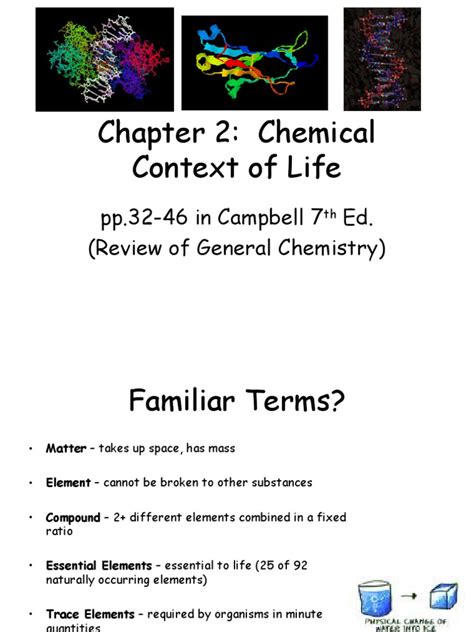Introduction
This article delves into the fundamental concepts of Chapter 2 of Campbell’s AP Biology textbook, exploring the building blocks of life and the interactions that govern their behavior. From atoms and molecules to chemical reactions and energy, we’ll unravel the intricate chemistry that underpins all biological processes.

The Building Blocks of Life
Atoms and Elements
Atoms are the fundamental unit of matter, composed of a nucleus containing protons and neutrons, and electrons orbiting the nucleus. Each element is defined by its unique number of protons, which determines its atomic number.
Molecules and Compounds
Molecules are formed when atoms combine, creating new substances with properties distinct from their constituent elements. Compounds are molecules composed of atoms of different elements. For example, water is a compound made of hydrogen and oxygen atoms.
Chemical Reactions
Chemical Bonds
Atoms interact through chemical bonds, which hold them together to form molecules. There are various types of bonds, including covalent bonds, ionic bonds, and hydrogen bonds.
Endergonic and Exergonic Reactions
Chemical reactions can be classified as either endergonic or exergonic based on their energy changes. Exergonic reactions release energy, while endergonic reactions absorb energy.
Water and Life
Water is essential for life on Earth, making up about 60% of our bodies and covering 70% of the planet’s surface. Its unique properties, such as its high specific heat capacity and cohesive forces, contribute to its vital role in biological processes.
Acids, Bases, and pH
Acids and bases are substances that can donate or accept protons, respectively. pH is a measure of the concentration of hydrogen ions in a solution, indicating its acidity or basicity. Most biological processes function within a narrow pH range.
Buffers
Buffers are solutions that resist changes in pH when acids or bases are added. They play a crucial role in maintaining the optimal pH for cellular processes.
Energy in Biological Systems
ATP: The Energy Currency of Cells
Adenosine triphosphate (ATP) is the primary energy currency of cells. It is a small molecule that undergoes hydrolysis to release energy used to drive various cellular processes.
Metabolism
Metabolism encompasses all the chemical reactions that occur within cells, including energy production and utilization, and the synthesis and breakdown of biomolecules.
Common Mistakes to Avoid
- Confusing atoms with molecules
- Misunderstanding the concept of chemical bonds
- Oversimplifying the thermodynamics of chemical reactions
- Ignoring the importance of water in biological systems
- Underestimating the significance of pH regulation
Effective Strategies for Understanding Chapter 2
- Study the figures and tables: The textbook provides numerous visual aids that clarify complex concepts.
- Review the key terms: Familiarize yourself with the vocabulary specific to this chapter.
- Solve practice problems: Applying theoretical concepts to real-world scenarios strengthens understanding.
- Attend class lectures and participate in discussions: Engaging with the material and asking questions promotes comprehension.
- Utilize online resources: Seek supplemental materials and interactive simulations to enhance learning.
Step-by-Step Approach to Chapter 2
- Understand the basic structure of atoms and molecules.
- Learn about the different types of chemical bonds.
- Study the principles of chemical reactions.
- Explore the properties of water and its importance in life.
- Understand the concepts of acids, bases, and pH.
- Investigate the role of buffers in maintaining pH.
- Learn about ATP and metabolism.
New Applications and Innovations
The chemical principles presented in this chapter lay the groundwork for numerous applications and innovations in the field of biology:
- Biomaterials: Understanding the chemical interactions between biological molecules and materials allows for the development of biocompatible implants and devices.
- Drug design: Knowledge of chemical bonding and molecular structure aids in the design of effective and targeted drugs.
- Nanotechnology: Manipulating the chemical interactions at the nanoscale enables the creation of novel materials and devices for medical and industrial applications.
- Environmental remediation: Understanding the chemical processes involved in pollution and degradation facilitates the development of strategies for environmental restoration.
Conclusion
AP Bio Campbell Textbook Chapter 2 provides a comprehensive overview of the chemical context of life. By mastering the concepts of atomic structure, chemical reactions, and energy dynamics, students gain a solid foundation for understanding the intricacies of biological systems. Through effective study strategies and a keen grasp of the material, students can unlock the secrets of the chemical realm and appreciate its profound impact on all living organisms.
